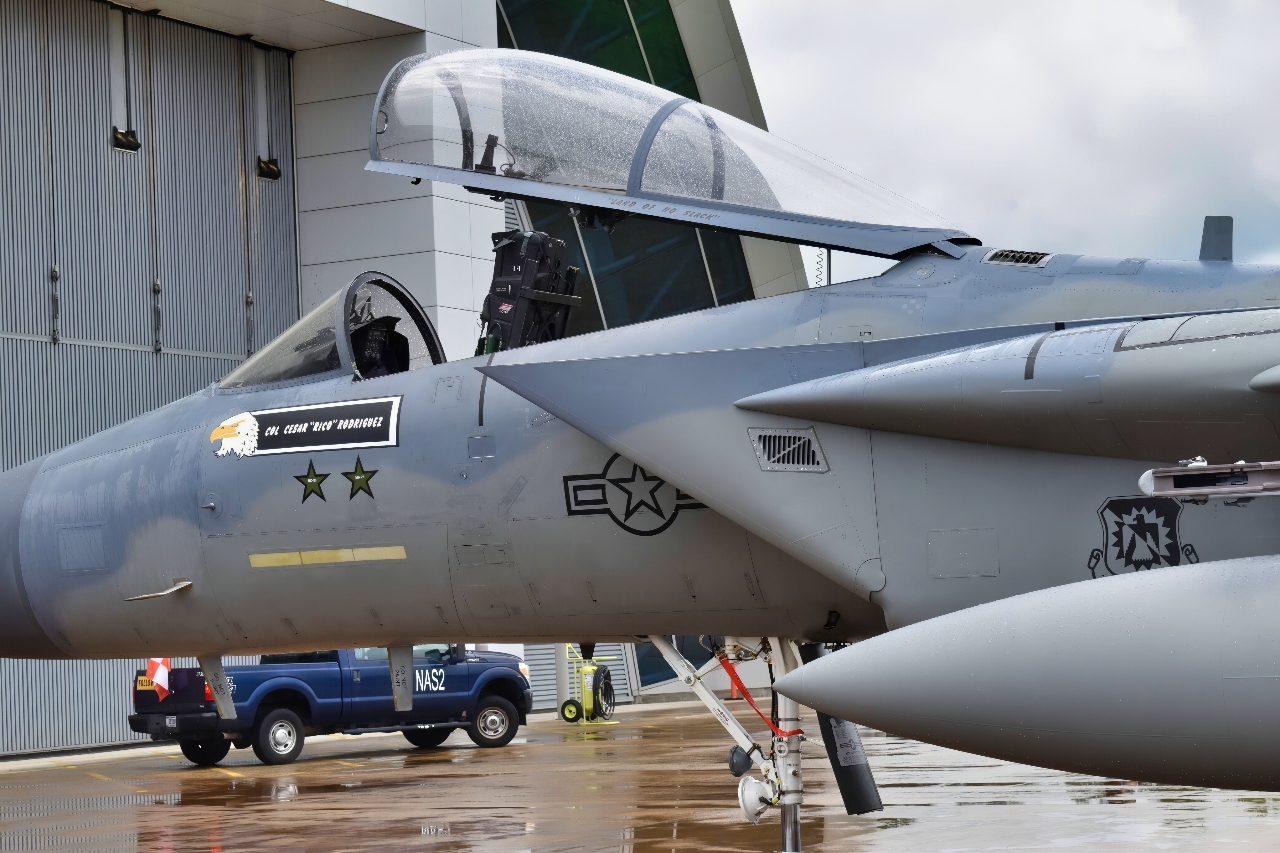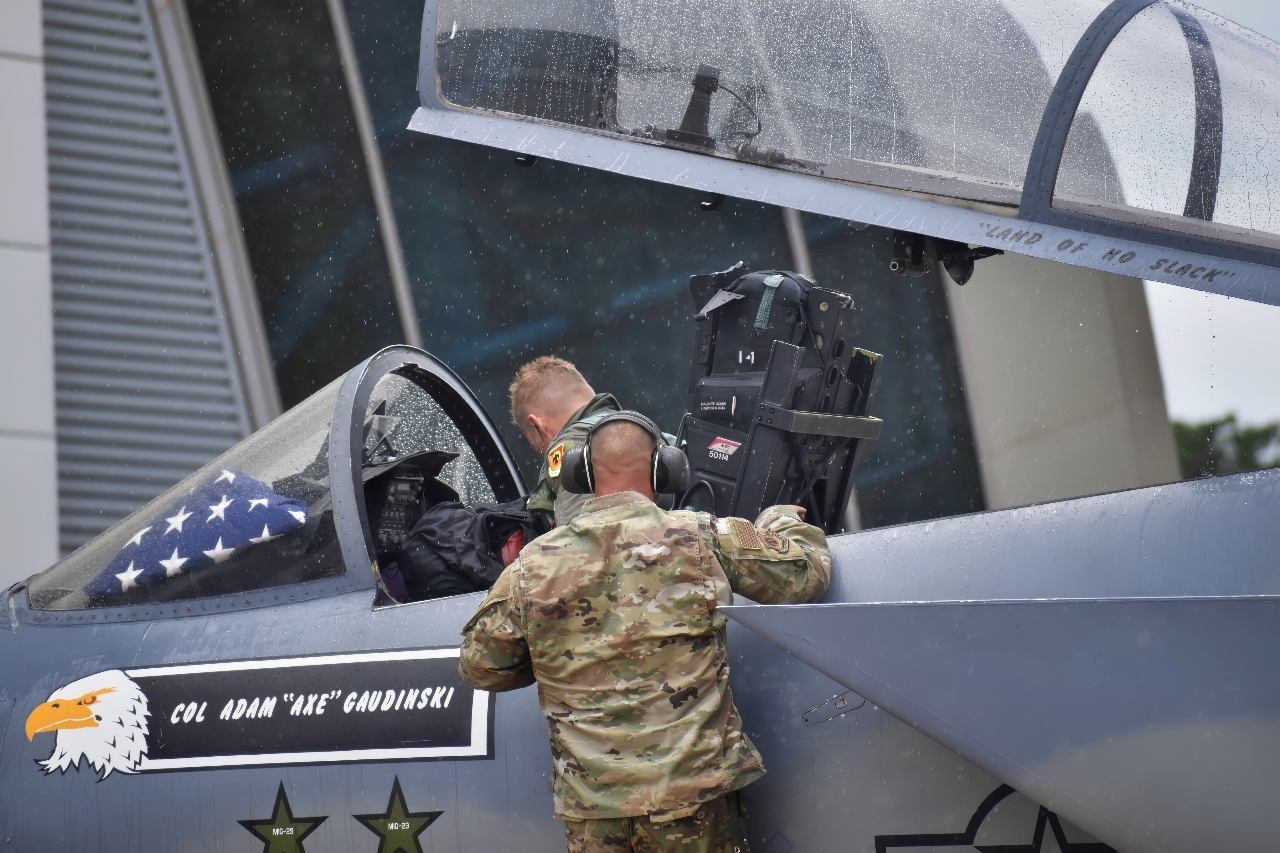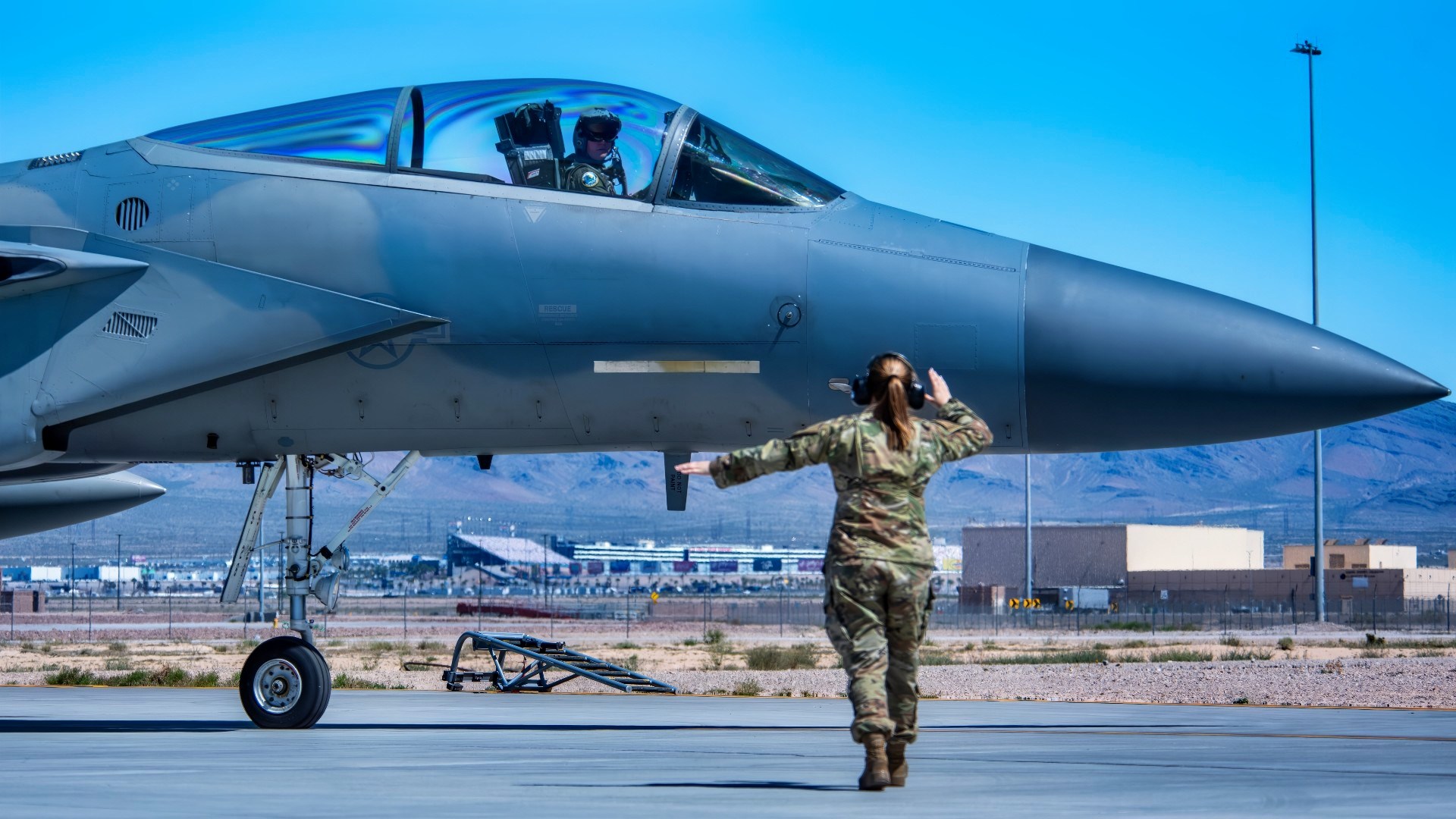Key Points and Summary – In this article, we attempt to explain the “headbutt” maneuver, a fighter jet tactic that the U.S. Air Force has used at least twice in 2025 to intercept civilian planes violating airspace around President Trump’s residences.
-Despite its aggressive name, the maneuver involves no physical contact.

F-15C Fighter at Smithsonian August 13 2025. Image Credit: National Security Journal.

F-15C in the Rain at Smithsonian Outside DC. Image Credit: Brent Eastwood/National Security Journal.
-It is a last-resort visual warning where an intercepting jet performs a dramatic vertical climb in front of the other aircraft to get the pilot’s attention.
-The tactic, emphasized since 9/11 for domestic intercepts, is also used in combat as a final warning before opening fire, as was demonstrated over Syria in 2017.
What Is a Fighter Jet ‘Headbutt’?
At least twice so far this year, fighter jets have had to execute a “headbutt” maneuver on civil aircraft that were flying too close to U.S. President Donald Trump’s residences in Florida and New Jersey.
Back in April, a private pilot got into restricted airspace near Mar-a-Lago, according to NORAD, as cited by WPTV.
They were required to “scramble Air Force jets and perform a drastic maneuver known as a ‘head butt’ to get the pilot’s attention.” As a result, the pilot was escorted out of the restricted airspace.
The pilot “faces fines and the suspension or loss of his license.”
“NORAD and the FAA work closely together to keep the skies over America safe, with close attention paid to areas with Temporary Flight Restrictions (TFR),” Gen. Gregory Guillot, Commander, NORAD and U.S. Northern Command, said in a statement at the time.
New Jersey Headbutt
In July it happened again, this time in restricted airspace over Bedminster, New Jersey, the home of the golf club where the president spends most weekends in the summer. NorthJersey.com wrote the following day about the “chaos” that had taken place over Mar-a-Lago over the holiday weekend.

F-15C Fighter at Smithsonian National Security Journal Photo
Per Fox 13 News, it was a similar story as the April incident, with jets scrambled, carrying out a “headbutt” maneuver, and ultimately escorting the jet out of the restricted airspace.
In fact, it was one of at least four airspace incursions that day, although not all required jets to scramble, and it appeared only one headbutt was required.
“Attention all pilots: If you’re flying anywhere near Bedminster, NJ, you’d better check NOTAMs 1353, 1358, 2246, and 2247,” The official X account of First Air Force posted on July 5. “These TFRs are in place for a reason. No excuses! Stay sharp, stay legal, and stay out of restricted airspace.”
The week before the April incident, TV station WPBF had written about a simulation of how “NORAD fighter pilots are trained to intercept aircraft that violate Temporary Flight Restrictions—like the one that goes into effect every time President Donald Trump visits Mar-a-Lago.
“The whole point when we wind up having to intercept somebody is to let that Cessna, that whatever airplane it is known, an armed air defense fighter’s pulled up alongside,” Lt. Col. Alex Papp told the station. However, Papp noted that headbutts are rare and that he had never done one himself. He added that “once people notice that there’s a fighter pulled up on their wing, they get on the radio pretty fast and they become compliant pretty quick.”
As of late March, there had been 24 restricted airspace violations near Mar-a-Lago—just in the first two months that Trump was back in office.
There may have been other domestic headbutt maneuvers this year, but those two are the only ones to make the news in 2025.
In 2023, an F-35 carried out a headbutt maneuver over Marin County, California, while President Joe Biden was visiting there for a fundraiser and a plane got into his airspace.
How Headbutts Work
A headbutt in human-on-human fighting, involves one person hitting someone else’s head with their own; usually.
In May, according to the New York Post, a female passenger on a flight from Spain to Scotland was kicked off, and “headbutted doors and windows after getting confronted over vaping during her flight.”

Lt. COl. Stephen ‘Steagle’ Mindek, 104th Fighter Wing pilot, takes off in an F-15C Eagle for Maj. John “Space’ Stout’s fini-flight, January 10, 2025, at Barnes Air National Guard Base, Westfield, Massachusetts.
Following the fini-flight, Maj. Stout was greeted with cheers from his fellow Airmen, friends, and family. Maj. Stout’s final ride in the F-15C Eagle resulted in over 1100 hours flown in the legendary aircraft.
(U.S. Air National Guard photo by Jay Hewitt)
But that isn’t exactly how it works with jets.
According to We Are the Mighty, the headbutt maneuver is “sweet but not nearly as metal as it sounds.” A few different things meet the definition of the word, but none involve actual physical contact between planes.
Per the piece, headbutts are usually a last resort, once methods such as lethal fires or radioing the other jet haven’t worked.
“Another version of the headbutt, usually seen when the Air Force is trying to get the attention of a friendly or civilian aircraft, has the headbutting jet fly well underneath the target aircraft, then fly up nearly vertical about 500 feet ahead of the friendly plane’s nose, almost guaranteeing that the pilot will see the U.S. fighter without forcing the pilot to fly though a violent or dangerous wake,” We Are the Mighty wrote.
Another version involves only one jet pulling it off.
A Headbutt Over Syria
Headbutts don’t happen only in the U.S. As reported by CNN, one took place in June 2017 over the skies of Syria.
The headbutt in that instance took place as part of a wider sequence of events.
“They saw the Su-22 approaching,” Navy Capt. Jeff Davis, a Pentagon spokesman, told reporters after the incident took place. “It again had dirty wings; it was carrying ordinance. They did everything they could to try to warn it away. They did a headbutt maneuver, they launched flares, but ultimately the Su-22 went into a dive, and it was observed dropping munitions and was subsequently shot down.”
In that case, when an AIM-120 Advanced Medium-Range Air-to-Air Missile was deployed, the defending F/A-18E/F Super Hornet became the first U.S. warplane to shoot down a manned aircraft since 1999.
A Change in Attitude
Per We Are the Mighty, the emphasis on headbutt maneuvers has come about since the 9/11 attacks, when “an Air Force that had always been aimed at foreign enemies had to be prepared to assess threats in the domestic airspace much more often.”
Often, this has involved fighter pilots, who are used to flying very fast, needing to interface with private planes that are going very slowly.
“Thanks to all these efforts, the U.S. Air Force has never had to shoot down a civilian plane, and its pilots gained experience using a valuable tool for deterring enemy planes near U.S. forces abroad.”
About the Author: Stephen Silver
Stephen Silver is an award-winning journalist, essayist, and film critic, and contributor to the Philadelphia Inquirer, the Jewish Telegraphic Agency, Broad Street Review, and Splice Today. The co-founder of the Philadelphia Film Critics Circle, Stephen lives in suburban Philadelphia with his wife and two sons. For over a decade, Stephen has authored thousands of articles that focus on politics, national security, technology, and the economy. Follow him on X (formerly Twitter) at @StephenSilver, and subscribe to his Substack newsletter.
More Military
Problem: U.S. Navy Nimitz-Class Aircraft Carriers Face 6 Year Long Refits
The Navy’s Ohio-Class SSGN Submarines Summed Up In 1 Sad Word
‘The Bow Was Ripped Off’: How a Russian Submarine Was Sunk By Its Own Faulty Torpedo
Forget the F-35, the Super Eurofighter Typhoon Is Coming
Forget the F-35: France’s F5 Super Dassault Rafale Fighter Is Coming










